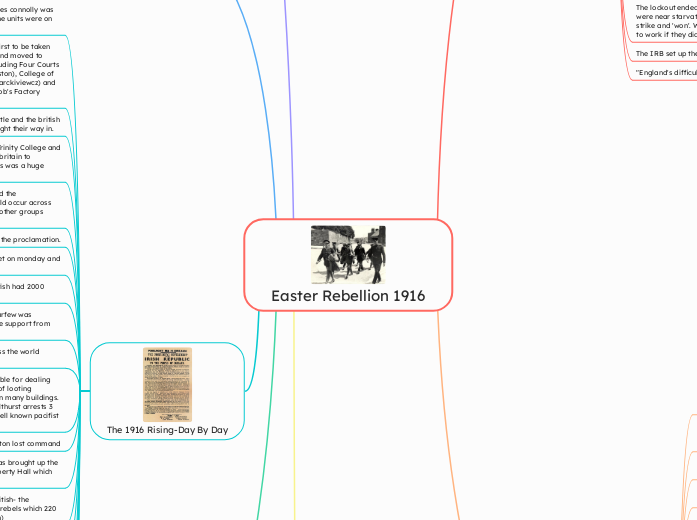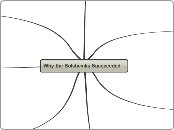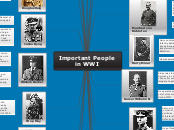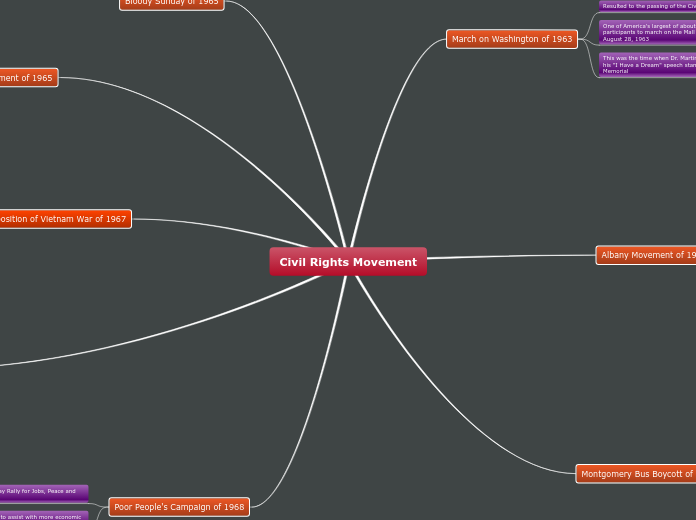Easter Rebellion 1916
The Leaders
Joseph Mary Plunkett, his father was Count Plunkett
He was a poet and director of the Irish Theatre
married to grace gifford
he was 29
Eamonn Ceant-interested in traditional music
one of the founding members of the IVF
in the south dublin union
Sean MacDiarmida revived the IRB
Thomas MacDonagh-also a member of the gaelic league
He was in Jacob's Factory
Thomas Clarke-59, explosion expert
also in the GPO
member of the gaelic league
Padraig Pearse was a teacher.
located in the GPO
Rising Outside Dublin
in wexford 100 volunteers took eniscorthy.
The most successful action during the war was in ahsbourne, co.meath where they surrounded a contingent of RIC where 90 prisoners were taken and 4 RIC barracks.
30,000 attended his funeral
thomas ashe
later went on hunger strike. was forcefed and died
The 1916 Rising-Day By Day
the surrendered rebels are held behind the rotunda where they are held
on saturday 29th april they surrendered and nurse elizabeth o'farrell at 12:45pm walked down the street carrying a white flag and delivering a message from the pearse to the british.
the o'rahilly who was shot several times by british forces. while dying he wrote a letter to his wife which you can see today. he was director of arms. he was from Kerry.
on friday pearse issued a statement admitting that the rising was almost over.
on thursday rebels could not communicate each other and james connolly was wounded in the ankle . Ceannt and De Valera's positions were heavily attacked.
general sir john maxwell took control of the british forces
The battle of mount street- the british- the sherwood foresters were shot by rebels which 220 soldiers were shot by only 17 men)
The Helga- a fisheries gun boa was brought up the liffey and shelled the GPO and Liberty Hall which forced the rebels out of GPO
On wednesday sean heuston lost command
General Lowe- was mad responsible for dealing with the rebellion on tueday. lots of looting occurred. the british put snipers on many buildings. The deranged Captain Bowen-Colthurst arrests 3 people and shot them including well known pacifist francis sheehy skeffington.
they transmitted a message across the world declaring an irish republic
Martial law (military rules) and curfew was imposed. the rebels attracted little support from dublin
by the end of the first day the british had 2000 troops
Pearse marched up sackville street on monday and charged the GPO.
Seven people signed the proclamation.
From the steps of the GPO he read the proclamation, hoping risings would occur across the country. this didn't happen as other groups were very badly organised.
They tried to take Dublin Castle, Trinity College and the railway stations. this allowed britain to transport troops to dublin and this was a huge mistake.
The british base was in Dublin castle and the british surrounded the GPO and they fought their way in.
The outpost at City Hall was the first to be taken then rebels then seized the GPO and moved to several points across the city including Four Courts (Daly), Mendicity Institution (Heuston), College of Surgeons (Mallin and Countess Marckiviewcz) and Boland's Mill (De valera) and Jacob's Factory (MacDonagh)
Monday April 24th- In theory james connolly was the leader but in reality each of the units were on their own
Why Did The Rising Fail?
the capturing of the aud
bad tactics by the volunteers
volunteers failed to get people's support.
british army had greater firepower
Irish volunteers outnumbered
The Results of The 1916 Rising
The Catholic Church opposed the executions and began to support radical nationalism.
The rising was called 'The Sinn Fein Rising' but they were not actually involved. In the 1918 general election influenced by the executions Sinn Fein won the general election. It was also the first election where women could vote. The Home Rule Party was destroyed with only 6 seats and Sinn Fein took 75 seats
Sinn Féin were anti-conscription opposed to the Home Rule Party.
Many of the prisoners joined Sinn Féin on masse.
The public began to change opinion after the shootings from hating the men to seeing them as political martyrs.
martial law was maintained for longer than necessary. curfew etc.
Countess Markievcz was sentenced to death but she was not shot because of her gender.
Eamonn De Valera was not executed because he was an American citizen
William Pearse was shot because of his brother Padraig
Thomas Kent was killed in London.
90 were sentenced to death and 60 were killed by Firing Squad. The 15 who signed to proclamation were sentenced to death. After these shootings public opinion changed into anti-british.
The prime minister was H. H. Asquith
after pressure from the home rule party the killings stopped.
Innocent prisoners were sent to Frongoch in Wales which was used to for German prisoners and they were moved out.
Extensive damage to Dublin's city centre.
Over 300 civilians were killed
64 rebels were killed and 157 British soldiers were killed
General Maxwell arrested more than 3400 men and 79 women suspected of being involved in the rising.
many were innocent which turned opinion against england
The IRB
The British had spies in the IRB and IVF but were lulled by McNeill's note in the newspaper.
Pearse-had an idea of blood sacrifice
They knew they were going to die but hoped they would inspire other Irish people to rise up.
They decided to go ahead anyway and had only 1250 men.
McNeill called off his volunteers in the newspaper.
Casement landed at Banna Beach, Co. Kerry and was waiting for rebels. He was captured and hanged at Pentonville Prison in August 1916 after the rising. He was also gay, which was illegal at the time.
Captain Spindler deliberately sinked the boat and The British captured them.
The boat was not expected until Sunday. Communication was not made.
The AUD, conatined 20,000 rifles and 1 million rounds of ammunition. Hidden by a consignment of timber and was destined for Ireland. The ship avoided all main shipping routes and arrived into Tralee Bay on Thursday 20th April.
He offered services to save captured irish soliders but this fell through.
Roger Casement, born a catholic and was raised a protestant in Antrim. Was a British diplomat.
McNeill found out The Castle Document was a forgery and pulled his support.
Every week The IRB would have marches in Dublin with hurleys.
The Castle Document was a fake document that said that The British authorities were going to arrest IVF leaders
Without the IVF there would be no rebellion.
Mac Neill was willing to fight if the British authority made any attempt to arrest the leadership of the IVF, if conscription were to be imposed on Ireland and if the british went back on their promise to bring in home rule for ireland.
Eoin Mac Neill was sceptical of a rising if there was no chance of winning.
James Connolly and Thomas McDonagh from the Citizen Army were brought on later and joined the miltary council.
Pearse made a famous speech at this burial. This brought him much attention.
O'Donovan Rossa (an old fenian) remains were brought back to Glasnevin.
The IRB wanted complete independence and utilised physical force.
The members were Padraig Pearese, Eamonn Ceant, Joseph Plunkett, Thomas Clarke and Sean Mac Diamarda
The IRB military council planned to carry out a rebellion to separate Ireland from England.
The Lockout
"England's difficulty is Ireland's opportunity."
The IRB set up the rising.
The lockout ended in early 1914 as most workers were near starvation. William Murphy broke the strike and 'won'. Workers were allowed to go back to work if they didn't join a union.
For seven months the lockout went on and Larkin was portrayed as a villain by Murphy's newspapers.
James Connolly formed The Irish Citizen Army in 1913 to protect the workers. The Citizen army believed in violent rebellion.
workers began protesting and the employers employed the RIC to beat and assault the protestors.
the employers employed blackleg workers, people who replaced the strikers at their jobs.
william murphy ordered a lockout of any ITGWU members. not allowed to work.
1913 strike of tram drivers for the dublin horse show.
The ITGWU was the first Irish trade union and they took in both skilled and unskilled workers. It was very popular and spread fast to other cities
There was a lack of opportunity for unskilled workers with no trade unionisation.
In 1913 one third of Dublin's population lived in slums. the infant mortality rate was 142 per 1000 births. Tuberclosis spread, caused by poor living conditions. 4 million pledges were taken in by the pawnbroker as people were trying to make money.
William Murphy-employer, doesn't want employees to join unions.
Concerned with the right to unionise.
20,000 workers involved, 26th August 1913 to 18th jan 1914.
The 1913 strike by ITGWU (Transport and General Workers). led by james larkin









